Abstract
Dismutation of superoxide has been shown previously to be catalyzed by stable nitroxide compounds. In the present study, the mechanism of superoxide (.O2-) dismutation by various five-membered ring and six-membered ring nitroxides was studied by electron paramagnetic resonance spectrometry, UV-visible spectrophotometry, cyclic voltammetry, and bulk electrolysis. Electron paramagnetic resonance signals from the carbocyclic nitroxide derivatives (piperidinyl, pyrrolidinyl, and pyrrolinyl) were unchanged when exposed to enzymatically generated .O2-, whereas, in the presence of .O2- and reducing agents such as NADH and NADPH, the nitroxides underwent reduction to their respective hydroxylamines. The reaction of 4-hydroxy-2,2,6,6-tetramethyl-1-hydroxypiperidine (Tempol-H) with .O2- was measured and, in agreement with earlier reports on related compounds, the rate was found to be too slow to be consistent with a mechanism of .O2- dismutation involving the hydroxylamine as an intermediate. Voltammetric analyses of the carbocyclic nitroxide derivatives revealed a reversible one-electron redox couple at positive potentials. In contrast, oxazolidine derivatives were irreversibly oxidized. At negative potentials, all of the nitroxides studied exhibited a broad, irreversible reductive wave. The rate of .O2- dismutation correlated with the reversible midpoint redox potential. Bulk electrolysis at positive potentials was found to generate a metastable oxidized form of the nitroxide. The results indicate that the dismutation of .O2- is catalyzed by the oxoammonium/nitroxide redox couple for carbocyclic nitroxide derivatives. In addition to the one-electron mitochondrial reduction pathway, the present results suggest the possibility that cellular bioreduction by a two-electron pathway may occur subsequent to oxidation of stable nitroxides. Furthermore, the cellular destruction of persistent spin adduct nitroxides might also be facilitated by a primary univalent oxidation.
Full text
PDF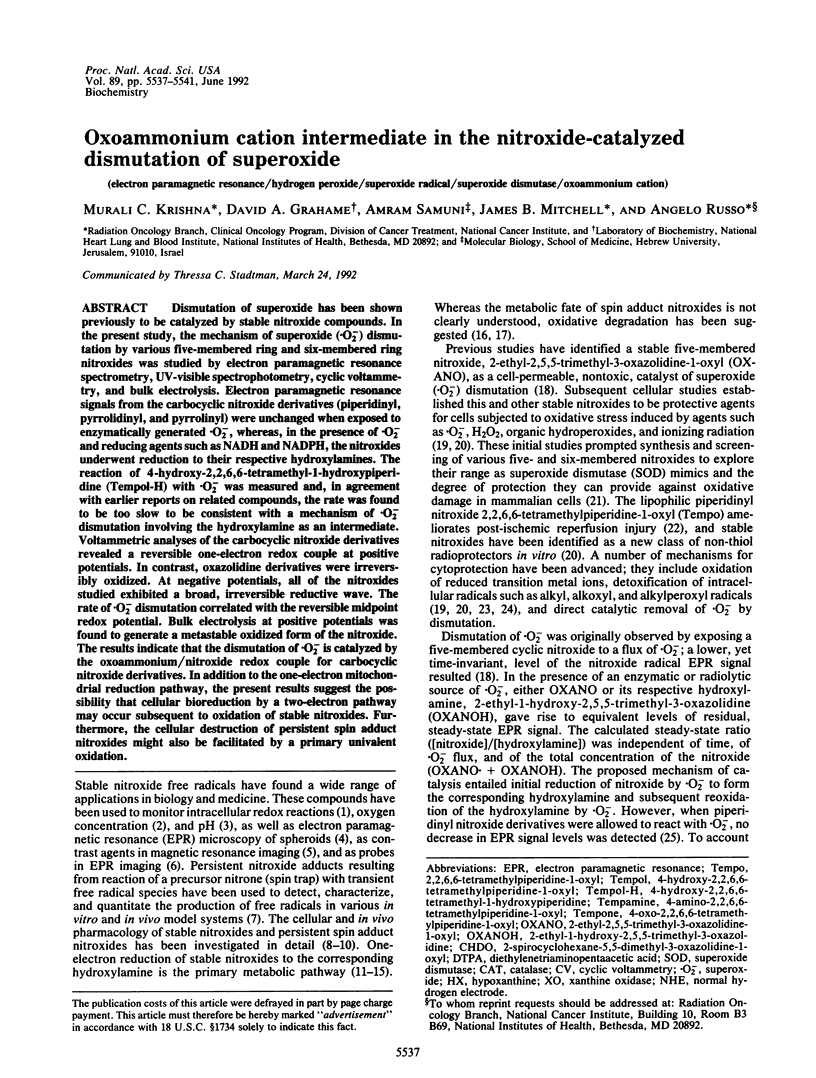
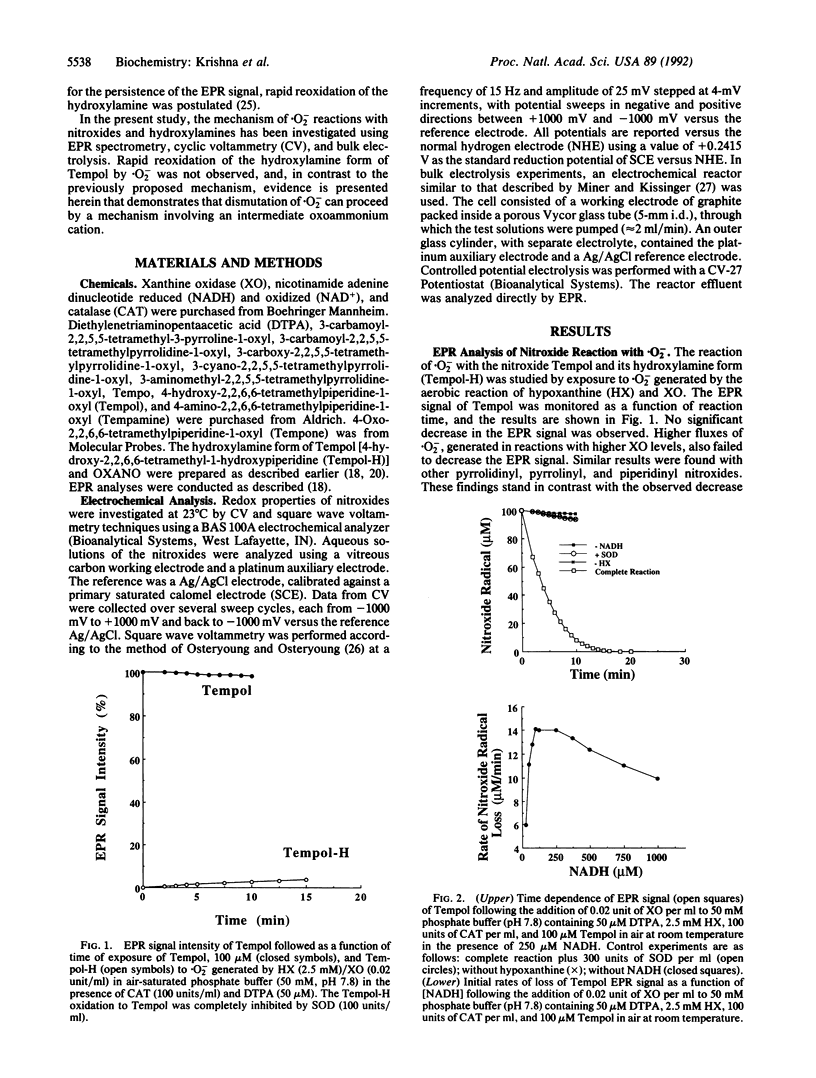
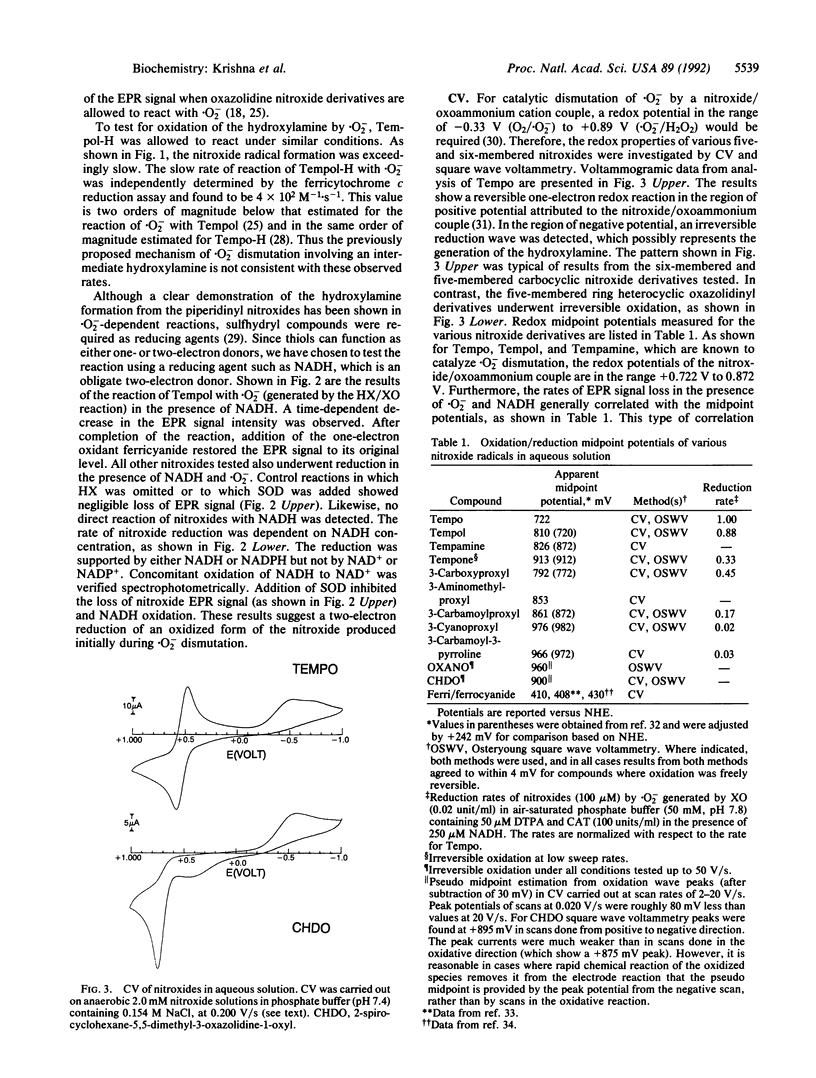
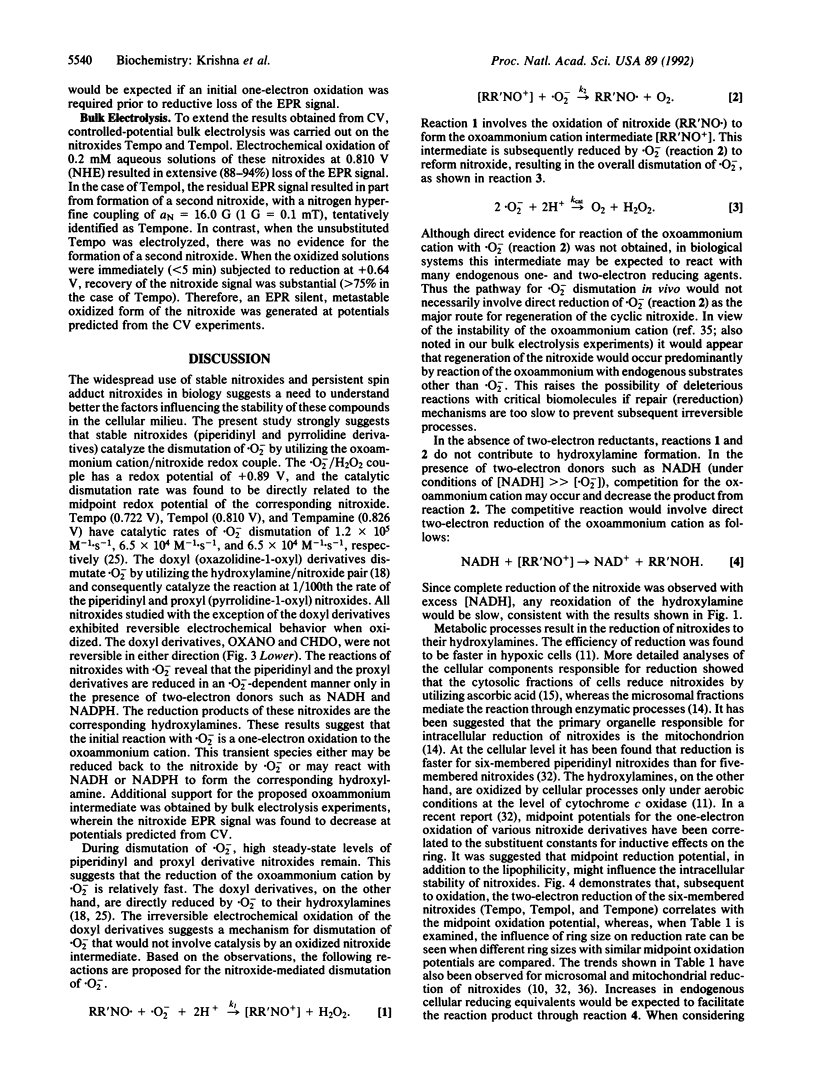
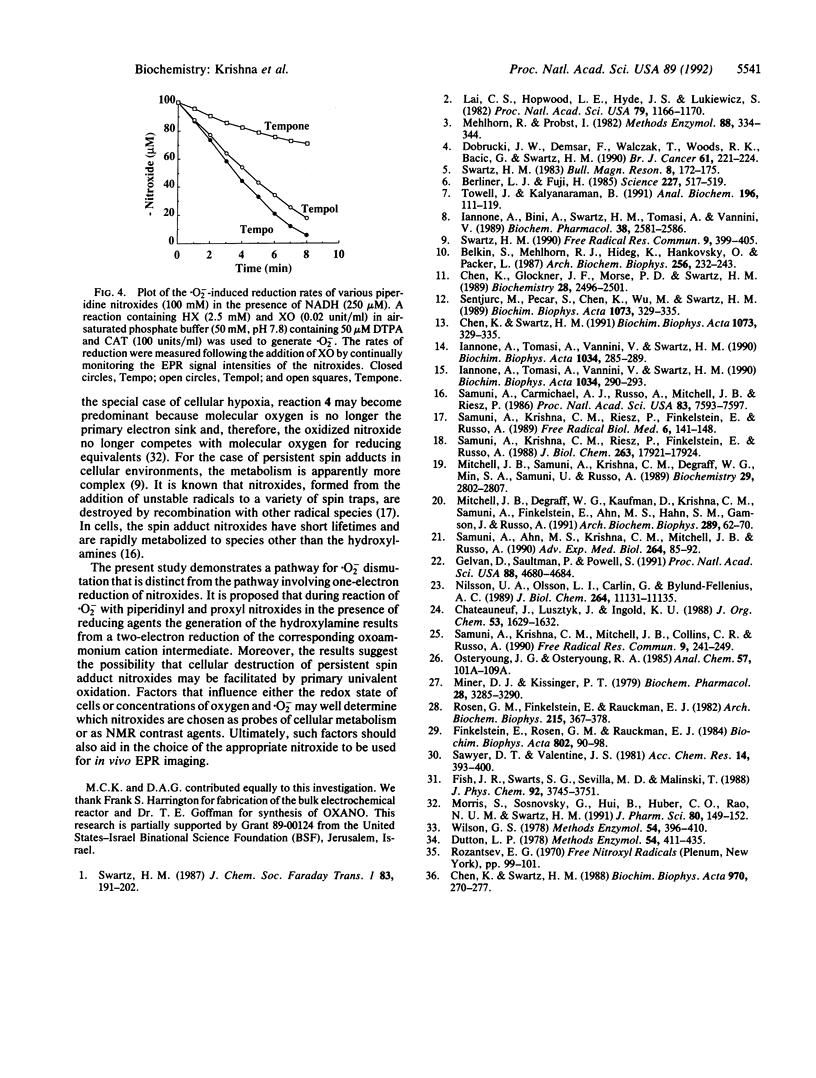
Selected References
These references are in PubMed. This may not be the complete list of references from this article.
- Belkin S., Mehlhorn R. J., Hideg K., Hankovsky O., Packer L. Reduction and destruction rates of nitroxide spin probes. Arch Biochem Biophys. 1987 Jul;256(1):232–243. doi: 10.1016/0003-9861(87)90441-3. [DOI] [PubMed] [Google Scholar]
- Berliner J. L., Fujii H. Magnetic resonance imaging of biological specimens by electron paramagnetic resonance of nitroxide spin labels. Science. 1985 Feb 1;227(4686):517–519. doi: 10.1126/science.2981437. [DOI] [PubMed] [Google Scholar]
- Chen K., Glockner J. F., Morse P. D., 2nd, Swartz H. M. Effects of oxygen on the metabolism of nitroxide spin labels in cells. Biochemistry. 1989 Mar 21;28(6):2496–2501. doi: 10.1021/bi00432a022. [DOI] [PubMed] [Google Scholar]
- Chen K., Swartz H. M. Oxidation of hydroxylamines to nitroxide spin labels in living cells. Biochim Biophys Acta. 1988 Jul 29;970(3):270–277. doi: 10.1016/0167-4889(88)90126-7. [DOI] [PubMed] [Google Scholar]
- Dobrucki J. W., Demsar F., Walczak T., Woods R. K., Bacic G., Swartz H. M. Electron spin resonance microscopy of an in vitro tumour model. Br J Cancer. 1990 Feb;61(2):221–224. doi: 10.1038/bjc.1990.41. [DOI] [PMC free article] [PubMed] [Google Scholar]
- Dutton P. L. Redox potentiometry: determination of midpoint potentials of oxidation-reduction components of biological electron-transfer systems. Methods Enzymol. 1978;54:411–435. doi: 10.1016/s0076-6879(78)54026-3. [DOI] [PubMed] [Google Scholar]
- Gelvan D., Saltman P., Powell S. R. Cardiac reperfusion damage prevented by a nitroxide free radical. Proc Natl Acad Sci U S A. 1991 Jun 1;88(11):4680–4684. doi: 10.1073/pnas.88.11.4680. [DOI] [PMC free article] [PubMed] [Google Scholar]
- Iannone A., Bini A., Swartz H. M., Tomasi A., Vannini V. Metabolism in rat liver microsomes of the nitroxide spin probe tempol. Biochem Pharmacol. 1989 Aug 15;38(16):2581–2586. doi: 10.1016/0006-2952(89)90541-8. [DOI] [PubMed] [Google Scholar]
- Iannone A., Tomasi A., Vannini V., Swartz H. M. Metabolism of nitroxide spin labels in subcellular fraction of rat liver. I. Reduction by microsomes. Biochim Biophys Acta. 1990 Jun 20;1034(3):285–289. doi: 10.1016/0304-4165(90)90052-x. [DOI] [PubMed] [Google Scholar]
- Iannone A., Tomasi A., Vannini V., Swartz H. M. Metabolism of nitroxide spin labels in subcellular fractions of rat liver. II. Reduction in the cytosol. Biochim Biophys Acta. 1990 Jun 20;1034(3):290–293. doi: 10.1016/0304-4165(90)90053-y. [DOI] [PubMed] [Google Scholar]
- Lai C. S., Hopwood L. E., Hyde J. S., Lukiewicz S. ESR studies of O2 uptake by Chinese hamster ovary cells during the cell cycle. Proc Natl Acad Sci U S A. 1982 Feb;79(4):1166–1170. doi: 10.1073/pnas.79.4.1166. [DOI] [PMC free article] [PubMed] [Google Scholar]
- Miner D. J., Kissinger P. T. Evidence for the involvement of N-acetyl-p- quinoneimine in acetaminophen metabolism. Biochem Pharmacol. 1979 Nov 15;28(22):3285–3290. doi: 10.1016/0006-2952(79)90123-0. [DOI] [PubMed] [Google Scholar]
- Mitchell J. B., DeGraff W., Kaufman D., Krishna M. C., Samuni A., Finkelstein E., Ahn M. S., Hahn S. M., Gamson J., Russo A. Inhibition of oxygen-dependent radiation-induced damage by the nitroxide superoxide dismutase mimic, tempol. Arch Biochem Biophys. 1991 Aug 15;289(1):62–70. doi: 10.1016/0003-9861(91)90442-l. [DOI] [PubMed] [Google Scholar]
- Mitchell J. B., Samuni A., Krishna M. C., DeGraff W. G., Ahn M. S., Samuni U., Russo A. Biologically active metal-independent superoxide dismutase mimics. Biochemistry. 1990 Mar 20;29(11):2802–2807. doi: 10.1021/bi00463a024. [DOI] [PubMed] [Google Scholar]
- Morris S., Sosnovsky G., Hui B., Huber C. O., Rao N. U., Swartz H. M. Chemical and electrochemical reduction rates of cyclic nitroxides (nitroxyls). J Pharm Sci. 1991 Feb;80(2):149–152. doi: 10.1002/jps.2600800212. [DOI] [PubMed] [Google Scholar]
- Nilsson U. A., Olsson L. I., Carlin G., Bylund-Fellenius A. C. Inhibition of lipid peroxidation by spin labels. Relationships between structure and function. J Biol Chem. 1989 Jul 5;264(19):11131–11135. [PubMed] [Google Scholar]
- Rosen G. M., Finkelstein E., Rauckman E. J. A method for the detection of superoxide in biological systems. Arch Biochem Biophys. 1982 May;215(2):367–378. doi: 10.1016/0003-9861(82)90097-2. [DOI] [PubMed] [Google Scholar]
- Samuni A., Carmichael A. J., Russo A., Mitchell J. B., Riesz P. On the spin trapping and ESR detection of oxygen-derived radicals generated inside cells. Proc Natl Acad Sci U S A. 1986 Oct;83(20):7593–7597. doi: 10.1073/pnas.83.20.7593. [DOI] [PMC free article] [PubMed] [Google Scholar]
- Samuni A., Krishna C. M., Mitchell J. B., Collins C. R., Russo A. Superoxide reaction with nitroxides. Free Radic Res Commun. 1990;9(3-6):241–249. doi: 10.3109/10715769009145682. [DOI] [PubMed] [Google Scholar]
- Samuni A., Krishna C. M., Riesz P., Finkelstein E., Russo A. A novel metal-free low molecular weight superoxide dismutase mimic. J Biol Chem. 1988 Dec 5;263(34):17921–17924. [PubMed] [Google Scholar]
- Samuni A., Krishna C. M., Riesz P., Finkelstein E., Russo A. Superoxide reaction with nitroxide spin-adducts. Free Radic Biol Med. 1989;6(2):141–148. doi: 10.1016/0891-5849(89)90111-1. [DOI] [PubMed] [Google Scholar]
- Samuni A., Min A., Krishna C. M., Mitchell J. B., Russo A. SOD-like activity of 5-membered ring nitroxide spin labels. Adv Exp Med Biol. 1990;264:85–92. doi: 10.1007/978-1-4684-5730-8_12. [DOI] [PubMed] [Google Scholar]
- Sentjurc M., Pecar S., Chen K., Wu M., Swartz H. Cellular metabolism of proxyl nitroxides and hydroxylamines. Biochim Biophys Acta. 1991 Mar 4;1073(2):329–335. doi: 10.1016/0304-4165(91)90139-8. [DOI] [PubMed] [Google Scholar]
- Swartz H. M. Principles of the metabolism of nitroxides and their implications for spin trapping. Free Radic Res Commun. 1990;9(3-6):399–405. doi: 10.3109/10715769009145700. [DOI] [PubMed] [Google Scholar]
- Towell J., Kalyanaraman B. Detection of radical adducts of 5,5-dimethyl-1-pyrroline n-oxide by the combined use of high-performance liquid chromatography with electrochemical detection and electron spin resonance. Anal Biochem. 1991 Jul;196(1):111–119. doi: 10.1016/0003-2697(91)90126-e. [DOI] [PubMed] [Google Scholar]
- Wilson G. S. Determination of oxidation-reduction potentials. Methods Enzymol. 1978;54:396–410. doi: 10.1016/s0076-6879(78)54025-1. [DOI] [PubMed] [Google Scholar]


